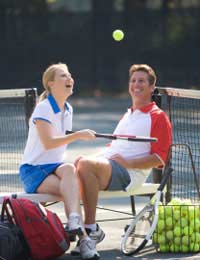Tennis: Mixed Doubles

Doubles play is all about dovetailing: one half of the team may be stronger on ground strokes and playing from the back of the court; the other may have the reflexes to be more adept at net play, able to read the intentions of opponents, and snuff out the threat and win the point almost before the ball has had the opportunity to cross the net chord. In terms of tennis, this is a marriage made in heaven.
The reality, particularly at amateur level, is that it’s a case of both partners working together to overcome the bad times and keep it together over the long-term, or at least the three sets they are currently involved in disputing. Sound familiar?
In common with single-sex doubles, the mixed-game partnership has to be based on the ability of both players to get along. There is no point squabbling over individual errors, or pointing the finger when a set is surrendered – it’s all about teamwork and team spirit.
Will You Be Able to Work Together?
So think carefully before suggesting teaming up with a player. That’s not to say you have to be the best of pals, or even partners, away from the court. This is not a popularity contest or a mutual admiration society we are forming here. The bottom line is: will you really be able to work together?Having found a promising partner, the next step is to set about finding how best to function on court. The patronising image of the man doing all the leg work and hitting the powerful fore- and backhand returns while the female floats around the service line ready to “dink” the ball back over the net belongs to a different century. Sex does not determine fitness levels, and it certainly is no basis for assessing technical ability. So start with a series of singles matches that will allow each partner to see the other in action and weigh up their strengths and weaknesses.
Then sit down and discuss each other’s observations. It is essential both players are frank about the other’s ability, or lack of ability in certain areas; otherwise the whole exercise will have been a waste of time. It’s true that, for example, some people don’t take kindly to being told their service is weak, but only honesty will result in a partnership that can maximise the strengths of each half of the team.
Seize the Initiative
These recognised strengths can lead to the development of a strategy that allows the team to quickly seize the initiative on court and ambush opponents by making them play to the strengths of each partner. Similarly a weakness, such as one partner’s service action, means a more defensive, rear-court set-up can be called into play when needed.As with all relationships, the mixed doubles partnership needs time to evolve and mature, to the point when awareness of the other’s positional play, or where to move at a particular moment, becomes second nature. It may sound like the sporting equivalent of marriage guidance, but never forget the importance of dialogue: talk before the match, between points, games, and sets, as well as after the match. Stick together through the bad times, and you’ll both experience a lot more highs than lows.
- Are Tennis Holidays Worth It?
- Executing the Smash
- Veterans tennis
- Tennis: Offensive and Defensive Lob
- Tennis: Singles or Doubles?
- Tennis: Service Technique
- Get to the Next Level
- Tennis: Get your Footwork Right
- Introduction to the Court and Different Surfaces
- Mental Strength: Don't get Angry, get Even
- Racket Grip
- Serve and Volley or Baseline?
- Basic Forehand and Backhand

